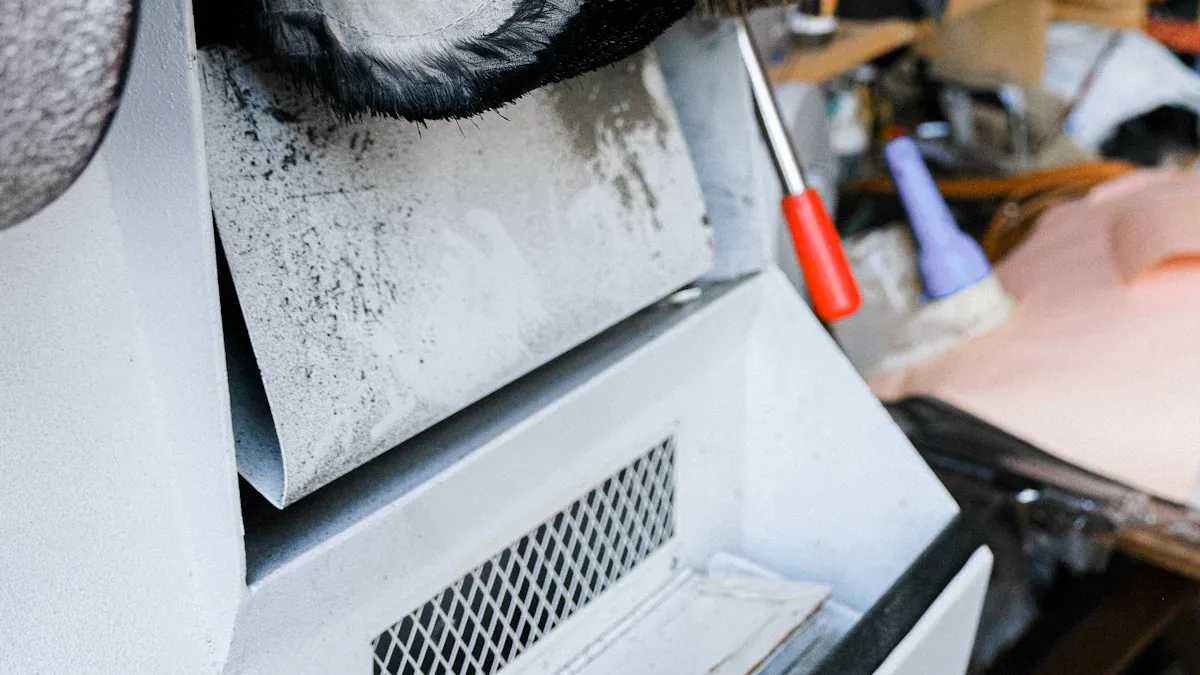If you’re looking for effective ways to save costs in a shoe manufacturer, focus on creating better designs, selecting smart materials, increasing work efficiency, and managing your workforce effectively. Additionally, save energy, control inventory carefully, and optimize your supply chain and distribution processes. Utilize practical tips and proven strategies. Trusted partners like Heley Chemical can also help you discover more ways to save costs in a shoe manufacturer.
Design Optimization
You can save a lot of money by making your shoe designs simpler. When you use fewer parts, you cut down on both material and labor costs. Simple designs are easier to make, so your workers spend less time on each pair. This means you can produce more shoes in less time. Mistakes also happen less often when the design is straightforward. Fewer errors mean less waste and fewer returns.
Think about the stitching, the number of layers, and the types of fasteners you use. If you choose easy-to-assemble parts, you speed up the whole process. You also make it easier to train new workers. When your team understands the design quickly, they work faster and make fewer mistakes. This keeps your quality high and your costs low.
Modular Components
Using modular components in your shoe designs brings many cost benefits. Here’s how modular parts help you save:
Modular components make upgrades, repairs, and recycling much easier. This lowers the total cost over the shoe’s life.
Fewer parts and more standard pieces mean you spend less on materials and labor.
Simple, modular designs shorten production cycles and reduce mistakes during assembly.
Big companies like Toyota and Dyson use modular parts to speed up assembly and cut waste. This leads to better quality and lower costs.
Tesla’s modular approach allows for easy upgrades and repairs. Planning for recycling also cuts down on disposal and raw material costs.
When you use modular components, you make your production line more flexible. You can swap out parts or update designs without starting from scratch. This keeps your business ready for changes and helps you stay ahead in the market.
Material Sourcing
Supplier Relationships
Having good relationships with suppliers helps you save money. It also keeps your factory working well. When you talk often with suppliers, you can get better prices. You may also get more time to pay. Good relationships help stop delays and shortages. Many big shoe companies do these things:
Pick suppliers with strong and eco-friendly materials.
Ask for lower prices and better payment plans.
Work together to fix problems fast.
Make sure suppliers follow fair and green rules.
Alternative Adhesives
Using cheaper adhesives is a smart way to save. Heley Chemical makes glues that are good and not expensive. Many shoe makers pick Heley because their glues work well and cost less. When you use strong adhesives like Heley’s, your shoes last and you spend less.
Production Efficiency
Making your factory work better helps you save money. If you use lean manufacturing, automation, and take care of machines, you waste less and make more shoes. These steps help you stop delays and get more shoes finished.
Automation
Automation means machines do hard jobs for you. Automated lasting machines can save up to 30% on labor. These machines make over 1,600 pairs of shoes in eight hours. They help keep quality high and mistakes low. With automation, your work moves faster and you make 20% more shoes. Machines with quick-change parts and computer controls work even better.
Preventive Maintenance
Taking care of machines before they break saves money. Here is how preventive maintenance helps:
You fix small problems before they get big.
You plan repairs when work is slow, so you do not lose time.
Service contracts give you discounts and help machines last longer.
You teach your team to spot problems early.
When you keep machines in good shape, you spend less each month. Your factory keeps running well.
Labor Management
Cross-Training
Cross-training your team is one of the smartest moves you can make in shoe manufacturing. When you teach workers more than one skill, you get a flexible team that can handle many jobs. This helps you keep your factory running smoothly, even when someone is out sick or on vacation. You do not have to stop production or rush to hire temporary workers.
Here’s how cross-training helps you save money and boost efficiency:
Workers can switch tasks quickly, so you avoid slowdowns.
You can handle busy seasons better because your team can fill in where needed.
Scheduling shifts gets easier since more people can do each job.
You cut down on downtime and keep your lines moving.
Your team feels more valued and motivated, which means they stay longer.
Cross-training also builds teamwork. When everyone understands different jobs, they help each other more. This makes your workplace friendlier and more productive. You also spend less on hiring and training new people because your current team can cover more roles.
Productivity Incentives
If you want your team to work harder and smarter, try offering productivity incentives. Simple rewards like bonuses, gift cards, or even a free lunch can make a big difference. When workers know they can earn something extra, they pay more attention to quality and speed.
You can set clear goals, like making a certain number of shoes each day or reducing mistakes. Celebrate wins together. This keeps everyone excited and focused. Happy workers do better work, and your factory saves money by making more shoes with fewer errors.
Energy Savings
Efficient Equipment
Using energy-saving machines helps you save money. Old machines use more power and break more often. Newer machines use less electricity and last longer. They also work faster than old ones. You do not spend as much on repairs. You also have less downtime.
Switch to LED lights in your factory. LED lights use less energy and last longer. Some machines have settings to save energy. You can turn off parts you do not need. This helps lower your costs.
Utility Reduction
It is not hard to lower your utility bills. Many shoe factories have found ways to save:
Use schedules so machines run only when needed.
Work during off-peak hours when power is cheaper.
Use software to track energy and water use.
Ask your utility company for better rates.
Try solar panels or other renewable energy.
Use lean manufacturing to cut waste.
Keep machines in good shape with regular care.
These steps help you use less power and water. You will pay less each month. Saving energy is also good for the planet, so everyone wins!
Inventory Control
Just-in-Time
If you want to save money in your shoe factory, try using just-in-time (JIT) inventory. This method helps you keep only what you need, right when you need it. You do not have to fill your warehouse with extra materials. Instead, you order supplies as soon as you get an order for shoes. This keeps your storage costs low and your space clear.
Here’s how JIT helps you:
You spend less on storage because you do not keep extra materials.
You avoid wasting money on old or unused items.
Your team works faster since they only handle what is needed for each order.
You spot mistakes quickly and fix them before they become big problems.
You use your machines better and finish orders faster.
You need less cash tied up in inventory, so you can use your money for other things.
Inventory Software
Managing inventory by hand can get messy. Inventory software makes your job much easier. You can track every box, every shoe, and every material with just a few clicks. The software shows you what you have, what you need, and when to order more.
With inventory software, you:
Avoid running out of important materials.
Cut down on mistakes and lost items.
Get alerts when stock is low.
Make smarter buying decisions.
Save time on paperwork.
Many shoe factories use inventory software to keep things simple and organized. When you know exactly what you have, you can plan better and save money every month.
Supply Chain
Shipment Consolidation
You can save a lot on shipping by combining smaller shipments into one big load. This method, called shipment consolidation, helps you use every inch of trailer space. When you fill up a truck, you pay less for each pair of shoes you send out. You also get better deals from shipping companies because you move more goods at once.
You cut down on the number of trucks needed.
Fewer trucks mean less money spent on fuel and drivers.
Your deliveries arrive on time more often.
You spend less time scheduling and unloading at the warehouse.
Supplier Diversification
Relying on just one supplier can be risky and expensive. If something goes wrong, your whole production line could stop. By working with several suppliers, you protect your business and keep costs down. You can compare prices, ask for better deals, and choose the best materials for your shoes.
You avoid delays if one supplier has problems.
You get more choices for materials and prices.
You can switch quickly if a supplier raises prices or lowers quality.
Some shoe companies even move their factories to countries with lower labor costs or better tax rules. Others use automation or outsource some work to save money. Sharing information with your suppliers also helps everyone work better together. When you build a strong, flexible supply chain, you keep your costs low and your business strong.
Distribution
Route Optimization
You can save money by planning delivery routes well. Smart route planning helps trucks drive fewer miles. This means you spend less on gas and paying drivers. Shoes get to customers faster, so they are happier. Many shoe companies use software to pick the best routes. These tools check traffic, weather, and delivery times. You avoid delays and do not waste trips.
Logistics Partners
The right logistics partners help you save a lot. Special logistics companies move shoes fast and safely. They use new technology to track shipments and manage inventory. You do not need to buy costly equipment or hire more workers. These partners help during busy times or when you launch new products.
Lower shipping and storage costs
Faster delivr peries
Betteackaging to keep shoes safe
Expert help with customs and rules
You can focus on making shoes while your partner does the rest. This is a great way to save costs in a shoe manufacturer.
Ways to Save Costs in a Shoe Manufacturer
Here are some ways to save costs in a shoe manufacturer’s distribution:
Use demand forecasting to match what you make with real orders.
Sell in stores and online shops.
Work with suppliers and retailers to share shipping and storage.
Use inventory systems to avoid too much or too little stock.
Pick eco-friendly shipping to save money and help the planet.




